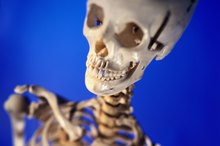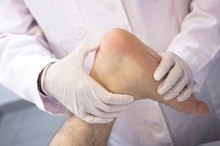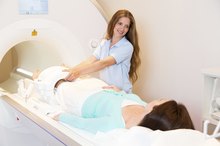Bone Eating Diseases
There are several bone-eating or osteolytic diseases. According to the Spine Universe website, bones are organs made from living tissue, an they provide a person's body with structural support. Cortical bone forms the outer layer of bones, and accounts for 80 percent of skeletal bone mass. Cancellous bone is a spongy material found inside the bone, and it accounts for the remaining 20 percent of skeletal bone mass. Osteolytic diseases interfere with bone structure, altering bone integrity and predisposing a person to fracture.
If you are experiencing serious medical symptoms, seek emergency treatment immediately.
Paget's Disease of Bone
Paget's disease of bone, or simply Paget's disease, is an osteolytic disease 2. According to the National Institute of Arthritis and Musculoskeletal and Skin Diseases (NIAMS)--a division of the National Institutes of Health--Paget's disease causes a person's bones to grow large and weak 2. In a normal, healthy individual, old bone is constantly being replaced by new bone--a process known as remodeling. Paget's disease interferes with this process, breaking down old bone faster than new bone can be produced. Over time, a person's body up-regulates the amount of new bone being made, such that new bone growth is faster than usual. The rapid generation of new bone causes the bones to enlarge, yet become softer and weaker, which predisposes a person to bone pain, deformities and fractures. According to the NIAMS, approximately one million Americans have Paget's disease. Paget's disease is more common in men than women.
- Paget's disease of bone, or simply Paget's disease, is an osteolytic disease 2.
- Paget's disease is more common in men than women.
Multiple Myeloma
Bone Deterioration Diseases
Learn More
Multiple myeloma is an osteolytic disease. The International Myeloma Foundation or IMF--an organization dedicated to preventing and curing myeloma--states that multiple myeloma is a cancer of the bone marrow, specifically of the white blood cells known as plasma cells. Plasma cells are antibody-producing cells, and a cancerous plasma cell is called a myeloma cell. The disease is called multiple myeloma because there are usually multiple patches in a bone where tumors have manifested. According to the IMF, the progression of multiple myeloma varies considerably from person to person. While it often progresses slowly, it can be more aggressive in some individuals. Common medical problems associated with multiple myeloma include the following: anemia or reduced red blood cells, high protein levels in the blood and urine, bone fractures and vertebral collapse, elevated blood calcium and reduced immunity. X-rays of affected areas often reveal bone with a moth-eaten appearance.
- Multiple myeloma is an osteolytic disease.
- The disease is called multiple myeloma because there are usually multiple patches in a bone where tumors have manifested.
Osteoporosis
Osteoporosis is a bone-eating disease. According to a 2001 article by Margie Patlak in "The Journal of the Federation of American Societies for Experimental Biology," over time, osteoporosis eats away at both cortical and trabecular bone, which causes large holes to form in the bones 3. Patlak states that these holes decrease a bone's structural integrity, and that without sufficient cortex and trabeculae, an osteoporotic bone can crack and collapse more easily when placed under stress, such as compression stress. The National Osteoporosis Foundation (NOF)--an organization dedicated to preventing osteoporosis and related fractures and improving lifelong bone health--states that, although any bone can be affected by osteoporosis, hip and spine osteoporosis are among the most dangerous 3. Osteoporosis-related fractures in these areas may require hospitalization and surgical intervention.
Related Articles
References
- Spine Universe: Basic Bone Structure
- National Institute of Arthritis and Musculoskeletal and Skin Diseases: What Is Paget's Disease of Bone?
- "FASEB"; Preventing and Treating Osteoporosis; Margie Patlak; 2001
- American Academy of Orthopedic Surgeons. (n.d.). Paget's Disease. https://orthoinfo.aaos.org/en/diseases--conditions/pagets-disease-of-bone/
- American Academy of Orthopedic Surgeons. (n.d.) Metastatic Bone Disease. https://orthoinfo.aaos.org/en/diseases--conditions/metastatic-bone-disease/
- American College of Rheumatology. (2019). Osteonecrosis. https://www.rheumatology.org/I-Am-A/Patient-Caregiver/Diseases-Conditions/Osteonecrosis
- Ferguson JL, Turner SP. Bone Cancer: Diagnosis and Treatment Principles. Am Fam Physician. 2018 Aug 15;98(4):205-13. https://www.aafp.org/afp/2018/0815/p205.html
- American Academy of Orthopedic Surgeons. (n.d.). Paget's Disease.
- American Academy of Orthopedic Surgeons. (n.d.) Metastatic Bone Disease.
- American College of Rheumatology. (2019). Osteonecrosis.
- Cohen A, Drake MT. (2017). Clinical manifestations, diagnosis, and treatment of osteomalacia. Snyder PJ, ed. UpToDate. Waltham, MA: UpToDate.
- Ferguson JL, Turner SP. Bone Cancer: Diagnosis and Treatment Principles. Am Fam Physician. 2018 Aug 15;98(4):205-13.
Writer Bio
Martin Hughes is a chiropractic physician, health writer and the co-owner of a website devoted to natural footgear. He writes about health, fitness, diet and lifestyle. Hughes earned his Bachelor of Science in kinesiology at the University of Waterloo and his doctoral degree from Western States Chiropractic College in Portland, Ore.








